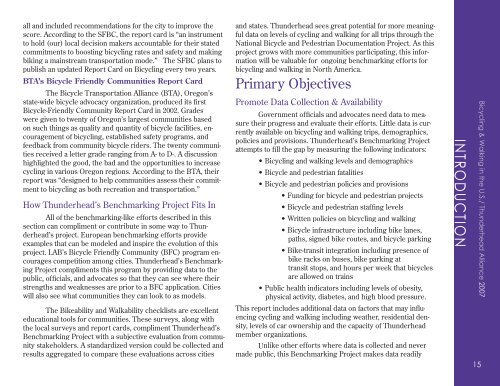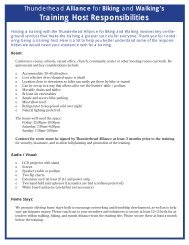2007 Benchmarking Report - Alliance for Biking & Walking
2007 Benchmarking Report - Alliance for Biking & Walking
2007 Benchmarking Report - Alliance for Biking & Walking
Create successful ePaper yourself
Turn your PDF publications into a flip-book with our unique Google optimized e-Paper software.
all and included recommendations <strong>for</strong> the city to improve the<br />
score. According to the SFBC, the report card is “an instrument<br />
to hold (our) local decision makers accountable <strong>for</strong> their stated<br />
commitments to boosting bicycling rates and safety and making<br />
biking a mainstream transportation mode.” The SFBC plans to<br />
publish an updated <strong>Report</strong> Card on Bicycling every two years.<br />
BTA’s Bicycle Friendly Communities <strong>Report</strong> Card<br />
The Bicycle Transportation <strong>Alliance</strong> (BTA), Oregon’s<br />
state-wide bicycle advocacy organization, produced its first<br />
Bicycle-Friendly Community <strong>Report</strong> Card in 2002. Grades<br />
were given to twenty of Oregon’s largest communities based<br />
on such things as quality and quantity of bicycle facilities, encouragement<br />
of bicycling, established safety programs, and<br />
feedback from community bicycle riders. The twenty communities<br />
received a letter grade ranging from A- to D-. A discussion<br />
highlighted the good, the bad and the opportunities to increase<br />
cycling in various Oregon regions. According to the BTA, their<br />
report was “designed to help communities assess their commitment<br />
to bicycling as both recreation and transportation.”<br />
How Thunderhead’s <strong>Benchmarking</strong> Project Fits In<br />
All of the benchmarking-like ef<strong>for</strong>ts described in this<br />
section can compliment or contribute in some way to Thunderhead’s<br />
project. European benchmarking ef<strong>for</strong>ts provide<br />
examples that can be modeled and inspire the evolution of this<br />
project. LAB’s Bicycle Friendly Community (BFC) program encourages<br />
competition among cities. Thunderhead’s <strong>Benchmarking</strong><br />
Project compliments this program by providing data to the<br />
public, officials, and advocates so that they can see where their<br />
strengths and weaknesses are prior to a BFC application. Cities<br />
will also see what communities they can look to as models.<br />
The Bikeability and Walkability checklists are excellent<br />
educational tools <strong>for</strong> communities. These surveys, along with<br />
the local surveys and report cards, compliment Thunderhead’s<br />
<strong>Benchmarking</strong> Project with a subjective evaluation from community<br />
stakeholders. A standardized version could be collected and<br />
results aggregated to compare these evaluations across cities<br />
and states. Thunderhead sees great potential <strong>for</strong> more meaningful<br />
data on levels of cycling and walking <strong>for</strong> all trips through the<br />
National Bicycle and Pedestrian Documentation Project. As this<br />
project grows with more communities participating, this in<strong>for</strong>mation<br />
will be valuable <strong>for</strong> ongoing benchmarking ef<strong>for</strong>ts <strong>for</strong><br />
bicycling and walking in North America.<br />
Primary Objectives<br />
Promote Data Collection & Availability<br />
Government officials and advocates need data to measure<br />
their progress and evaluate their ef<strong>for</strong>ts. Little data is currently<br />
available on bicycling and walking trips, demographics,<br />
policies and provisions. Thunderhead’s <strong>Benchmarking</strong> Project<br />
attempts to fill the gap by measuring the following indicators:<br />
• Bicycling and walking levels and demographics<br />
• Bicycle and pedestrian fatalities<br />
• Bicycle and pedestrian policies and provisions<br />
• Funding <strong>for</strong> bicycle and pedestrian projects<br />
• Bicycle and pedestrian staffing levels<br />
• Written policies on bicycling and walking<br />
• Bicycle infrastructure including bike lanes,<br />
paths, signed bike routes, and bicycle parking<br />
• Bike-transit integration including presence of<br />
bike racks on buses, bike parking at<br />
transit stops, and hours per week that bicycles<br />
are allowed on trains<br />
• Public health indicators including levels of obesity,<br />
physical activity, diabetes, and high blood pressure.<br />
This report includes additional data on factors that may influencing<br />
cycling and walking including weather, residential density,<br />
levels of car ownership and the capacity of Thunderhead<br />
member organizations.<br />
Unlike other ef<strong>for</strong>ts where data is collected and never<br />
made public, this <strong>Benchmarking</strong> Project makes data readily<br />
INTRODUCTION<br />
15<br />
Bicycling & <strong>Walking</strong> in the U.S./ Thunderhead <strong>Alliance</strong> <strong>2007</strong>



